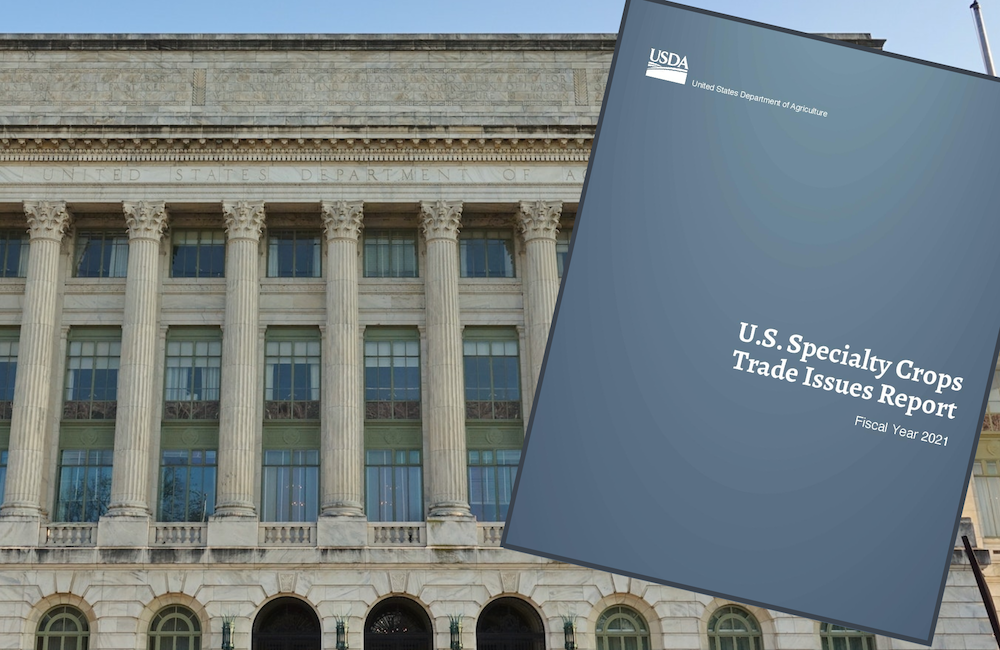The United States Department of Agriculture (USDA) recently issued its U.S. Specialty Crops Trade Issues Report for Fiscal Year 2021, introducing the findings on this high note:
In fiscal year 2021, the export value for U.S. specialty crops increased from $23.7 billion in 2020 to $24.9 billion in 2021. All specialty crop sectors experienced growth, including a 7.5% increase in processed fruits and vegetables. Additionally, the nursery sector rebounded strongly with 14.6% growth over fiscal year 2020. Global exports of U.S. wine were valued at approximately $1.44 billion, increasing 11% from fiscal year 2020.
It’s easy to be excited seeing U.S. specialty crop exports increase to almost $25 billion in 2021 at a time when growers and supply chains were still feeling the effects of the global pandemic. Drilling down into the report, the USDA reported that almost 70% of the shelled almond crop and about half of in-shell walnuts were exported. In fact, tree nuts represent more than 35% of the United States’ fiscal 2021 specialty crop exports.
Other crop segments included on the export list were fresh grapes, of which 14% of the total crop was exported, followed by just over 10% of citrus, and about 8% of apples and other pome fruit.
But all is not unicorns and daisies. As you dig deeper into the report, the USDA reveals a troubling 900-pound gorilla in the room that threatens to crash the party of U.S. specialty crop growers:
U.S. exports of fresh fruits and tree nuts continue to face difficulties from the European Union’s (EU) hazard-based approach to pesticide minimum residue limits (MRLs). The EU has removed critical pesticide MRLs for specialty crops, making import requirements more restrictive.
What the USDA does not say is these difficulties will only intensify for U.S. specialty crop growers—including hop farmers who export over one-third of their annual crop—the closer we get to 2030. That’s when the EU’s legally mandated 50% reduction of pesticide use goes into effect on crops raised within the E.U. What’s also interesting and likely to have far-reaching implications is European farmers must comply with mandatory record keeping on pesticide use.
The Commission did not detail the form in which mandatory record keeping must take. We think it’s safe to assume officials do not want growers to submit a stack of hand-written notes.
When the European Commission released these mandates in June 2022, it also signaled that these mandates will have a direct impact on growers in countries outside the EU that export to EU nations. The Commission said it would propose a measure that takes into account global environmental considerations when deciding on maximum residue levels (MRLs) in food.
Read this next bit carefully as it has a direct impact on U.S. specialty crop exporters. Imported food containing measurable residues of prohibited substances should, over time, not be marketed in the EU. This will … encourage third countries to also limit or prohibit the use of certain pesticides already banned in the EU.
Specifically, the Commission wants countries exporting to EU nations to reduce to zero the residues of thiamethoxam and clothianidin, two substances known to contribute to the worldwide decline of pollinators. These substances are not allowed in the EU.
The Commission went on to state that when the measure related to third party nations is adopted, imported food containing measurable residues of these two substances may—after certain transitional periods—can no longer be marketed in the EU.
This begs the question: where does the United States stand on these specific pesticides? In June 2022, the EPA released its findings on their biological evaluations assessing potential effects of these commonly used pesticides on endangered species plus a third, imidacloprid. The findings showed adverse effects on species or critical habitats ranging from 67% to 81%. The EPA has not outlawed the use of these pesticides. However, it is working with the U.S. Fish and Wildlife Service and the National Marine Fisheries Service on mitigation measures, including a reduction in air borne drift of these chemicals, which it plans to release in 2024.
You may be wondering why Smart Apply is bringing this topic up. The short answer is that we believe we have the solution: a one-of-a-kind precision spray system that combines LiDAR to help eliminate excess spraying of chemicals and the negative impacts of run off and airborne drift, with Cloud-connectivity that captures a wealth of data during each spray event. From this digital record, growers can track and document chemical use and savings, water use, that each and every row was sprayed (or not sprayed), manage labor, and support various domestic and international reporting requirements.
By retrofitting new or existing air blast sprayers, the Smart Apply System allows growers of specialty crops to easily and efficiently meet the immediate need of using less chemicals at less cost without sacrificing yields. It also solves more complicated challenges like satisfying mandates like those set forth by the EU from chemical use and documentation perspectives, balancing the growing scarcity of water and chemicals with feeding the world, preserving access to export markets, and minimizing environmental impact.
We admit this is a big lift for one company. We believe our team and the Smart Apply Intelligent Spray Control System are up for it. Visit our website for more information now. If you have specific questions, email us at Hello@SmartApply.com.


